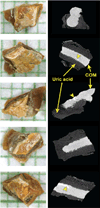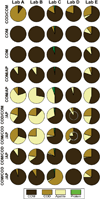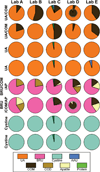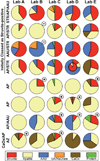Inaccurate reporting of mineral composition by commercial stone analysis laboratories: implications for infection and metabolic stones
- PMID: 20728108
- PMCID: PMC3164359
- DOI: 10.1016/j.juro.2010.05.089
Inaccurate reporting of mineral composition by commercial stone analysis laboratories: implications for infection and metabolic stones
Abstract
Purpose: We determined the accuracy of stone composition analysis at commercial laboratories.
Materials and methods: A total of 25 human renal stones with infrared spectroscopy determined composition were fragmented into aliquots and studied with micro computerized tomography to ensure fragment similarity. Representative fragments of each stone were submitted to 5 commercial stone laboratories for blinded analysis.
Results: All laboratories agreed on the composition of 6 pure stones. Only 2 of 4 stones (50%) known to contain struvite were identified as struvite at all laboratories. Struvite was reported as a component by some laboratories for 4 stones previously determined not to contain struvite. Overall there was disagreement regarding struvite in 6 stones (24%). For 9 calcium oxalate stones all laboratories reported some mixture of calcium oxalate but the quantity of subtypes differed significantly among laboratories. In 6 apatite containing stones apatite was missed by the laboratories in 20% of samples. None of the laboratories identified atazanavir in a stone containing that antiviral drug. One laboratory reported protein in every sample while all others reported it in only 1. Nomenclature for apatite differed among laboratories with 1 reporting apatite as carbonate apatite and never hydroxyapatite, another never reporting carbonate apatite and always reporting hydroxyapatite, and a third reporting carbonate apatite as apatite with calcium carbonate.
Conclusions: Commercial laboratories reliably recognize pure calculi. However, variability in the reporting of mixed calculi suggests a problem with the accuracy of stone analysis results. There is also a lack of standard nomenclature used by laboratories.
Copyright © 2010 American Urological Association Education and Research, Inc. Published by Elsevier Inc. All rights reserved.
Figures




Similar articles
-
Analysis of mixed stones is prone to error: a study with US laboratories using micro CT for verification of sample content.Urol Res. 2010 Dec;38(6):469-75. doi: 10.1007/s00240-010-0317-y. Epub 2010 Oct 22. Urol Res. 2010. PMID: 20967439
-
Carbonate in struvite stone detected in Raman spectra compared with infrared spectra and X-ray diffraction.Int J Urol. 1996 Jan;3(1):27-30. doi: 10.1111/j.1442-2042.1996.tb00625.x. Int J Urol. 1996. PMID: 8646595
-
Determination of the chemical composition of urinary calculi by noncontrast spiral computerized tomography.Urol Res. 2005 May;33(2):99-104. doi: 10.1007/s00240-004-0454-2. Epub 2005 Jan 6. Urol Res. 2005. PMID: 15645229
-
Causes of phosphate stone formation and the importance of metaphylaxis by urinary acidification: a review.World J Urol. 1999 Oct;17(5):308-15. doi: 10.1007/s003450050152. World J Urol. 1999. PMID: 10552150 Review.
-
Micro-computed tomography for analysis of urinary calculi.Urol Res. 2010 Dec;38(6):477-84. doi: 10.1007/s00240-010-0326-x. Epub 2010 Oct 22. Urol Res. 2010. PMID: 20967434 Review.
Cited by
-
Dual-Energy CT for Quantification of Urinary Stone Composition in Mixed Stones: A Phantom Study.AJR Am J Roentgenol. 2016 Aug;207(2):321-9. doi: 10.2214/AJR.15.15692. Epub 2016 May 25. AJR Am J Roentgenol. 2016. PMID: 27224260 Free PMC article.
-
High carbonate level of apatite in kidney stones implies infection, but is it predictive?Urolithiasis. 2013 Oct;41(5):389-94. doi: 10.1007/s00240-013-0591-6. Epub 2013 Jul 24. Urolithiasis. 2013. PMID: 23881525 Free PMC article.
-
Urine and stone analysis for the investigation of the renal stone former: a consensus conference.Urolithiasis. 2021 Feb;49(1):1-16. doi: 10.1007/s00240-020-01217-3. Epub 2020 Oct 13. Urolithiasis. 2021. PMID: 33048172 Free PMC article.
-
Association Between Randall's Plaque Stone Anchors and Renal Papillary Pits.J Endourol. 2019 Apr;33(4):337-342. doi: 10.1089/end.2018.0589. Epub 2019 Mar 20. J Endourol. 2019. PMID: 30793930 Free PMC article.
-
Performance of a Natural Language Processing Method to Extract Stone Composition From the Electronic Health Record.Urology. 2019 Oct;132:56-62. doi: 10.1016/j.urology.2019.07.007. Epub 2019 Jul 13. Urology. 2019. PMID: 31310771 Free PMC article.
References
-
- Daudon M. Analyse et classification des calculs: contribution à l’etiologie de la maladie lithiasique [Analysis and classification of calculi: contribution to the etiology of calculous disease] Revue medicale de la Suisse romande. 2004;124:445. - PubMed
-
- Daudon M, Bader CA, Jungers P. Urinary calculi: review of classification methods and correlations with etiology. Scanning Microsc. 1993;7:1081. - PubMed
-
- Mandel G, Mandel N. Analysis of stones. In: Coe FL, Favus MJ, Pak CYC, et al., editors. Kidney Stones: Medical and Surgical Managemant. Philadelphia: Lippencott-Raven; 1996. pp. 323–335.
-
- Schubert G. Stone analysis. Urol Res. 2006;34:146. - PubMed
-
- Goldstone L, Griffith DP. Infection calculi. In: Wickham JEA, Buck AC, editors. Renal Tract Stone. Metabolic Basis and Clinical Practice. London: Churchill Livingstone; 1990.
Publication types
MeSH terms
Substances
Grants and funding
LinkOut - more resources
Full Text Sources
Medical

